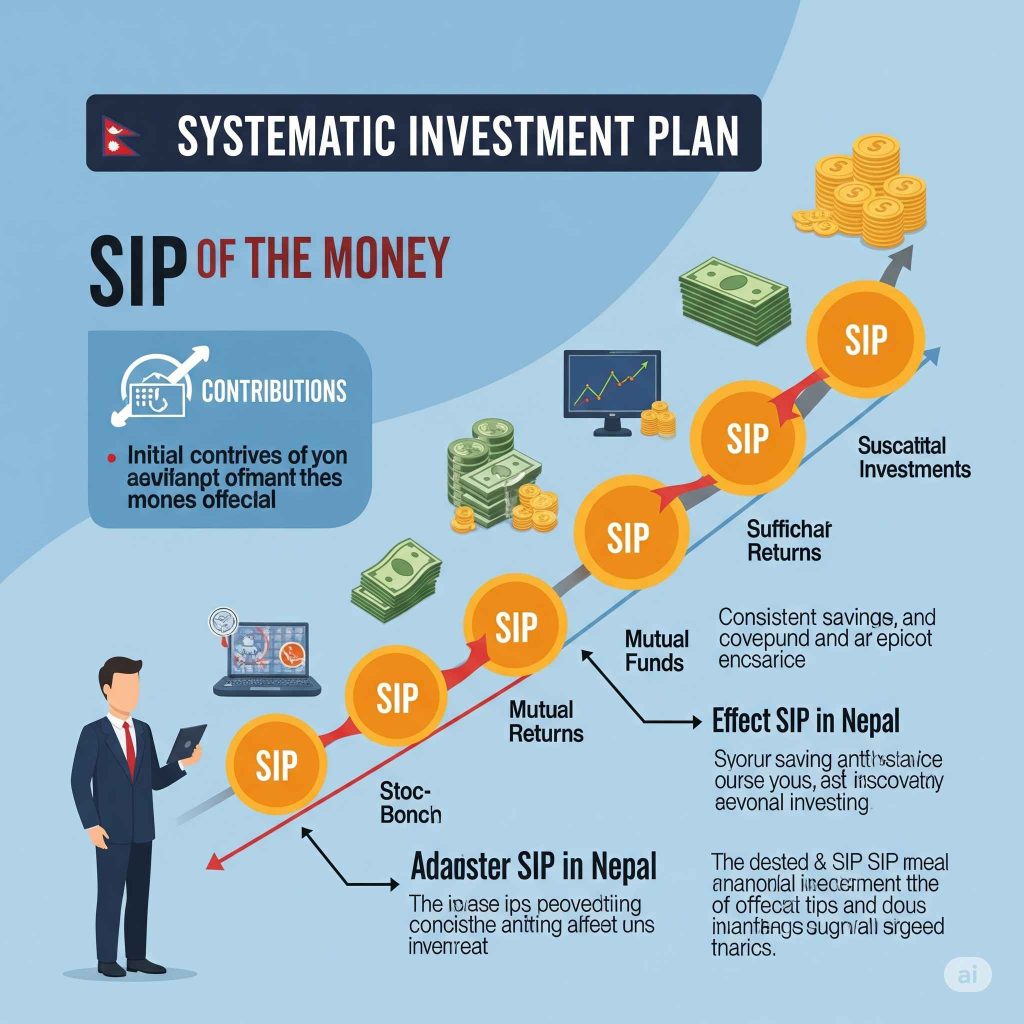
Introduction
Systematic Investment Plan (SIP) has revolutionized the way individuals approach investment in mutual funds. This disciplined investment strategy allows investors to build wealth systematically through regular, fixed contributions. Understanding SIP investment is crucial for anyone looking to achieve long-term financial goals through mutual fund investing.
SIP represents a paradigm shift from traditional lump-sum investing to a more structured, disciplined approach. This method has gained tremendous popularity due to its accessibility, flexibility, and potential for generating substantial returns over time.
What is SIP (Systematic Investment Plan)?
SIP is an investment method that allows investors to contribute a fixed amount regularly into mutual fund schemes. Instead of making a large one-time investment, SIP enables investors to invest smaller amounts consistently over predetermined periods, typically monthly.
The concept operates on the principle of rupee cost averaging, where investors purchase more units when prices are low and fewer units when prices are high. This approach helps reduce the impact of market volatility on investment returns.
How SIP Works: The Mechanism
Basic SIP Process
| Step | Process | Timeline |
|---|---|---|
| 1 | Investment Amount Fixed | Initial Setup |
| 2 | Auto-Debit Setup | Monthly/Quarterly |
| 3 | Unit Allocation | Based on NAV |
| 4 | Portfolio Building | Continuous |
Rupee Cost Averaging Concept
The fundamental principle behind SIP effectiveness is rupee cost averaging:
- Market High: Fewer units purchased with fixed amount
- Market Low: More units purchased with same amount
- Average Cost: Reduces over time through systematic buying
- Risk Mitigation: Minimizes timing risk in volatile markets
Types of SIP Investment Plans
Regular SIP
Regular SIP involves investing a fixed amount at predetermined intervals throughout the investment period. This is the most common type of SIP used by investors.
Features:
- Fixed investment amount
- Regular intervals (monthly/quarterly)
- Consistent investment discipline
- Suitable for long-term wealth creation
Top-up SIP
Top-up SIP allows investors to increase their investment amount periodically, typically annually. This helps counter inflation and increase investment corpus over time.
Benefits:
- Inflation adjustment capability
- Increased investment capacity
- Enhanced wealth creation potential
- Flexible increment options
Flexible SIP
Flexible SIP provides investors with the option to modify investment amounts based on their financial situation and market conditions.
Advantages:
- Investment amount flexibility
- Market condition adaptation
- Cash flow management
- Customized investment approach
Perpetual SIP
Perpetual SIP continues indefinitely until the investor decides to stop, without any predetermined end date.
Features:
- No fixed maturity date
- Continuous investment opportunity
- Long-term wealth building
- Flexibility in stopping
Benefits of SIP Investment
Financial Advantages
| Benefit | Description | Impact |
|---|---|---|
| Rupee Cost Averaging | Reduces average cost per unit | Risk Mitigation |
| Compounding Effect | Earnings generate additional returns | Wealth Multiplication |
| Disciplined Investing | Regular investment habit | Financial Discipline |
| Flexibility | Easy modification and exit | Convenience |
Practical Benefits
- Low Initial Investment: Start with amounts as low as ₹100-500
- Automated Process: Set-and-forget investment approach
- Professional Management: Expert fund management
- Diversification: Spread across multiple securities
- Liquidity: Easy redemption when needed
Tax Benefits
SIP investments in Equity Linked Savings Schemes (ELSS) offer:
- Section 80C Deduction: Up to ₹1.5 lakh annually
- Long-term Capital Gains: Favorable tax treatment
- Dividend Income: Tax-free in investor’s hands
- Wealth Creation: Tax-efficient wealth building
SIP vs Lump Sum Investment
Comparative Analysis
| Parameter | SIP | Lump Sum |
|---|---|---|
| Investment Amount | Small, regular | Large, one-time |
| Market Timing | Not required | Critical |
| Risk Factor | Lower | Higher |
| Flexibility | High | Limited |
| Discipline | Enforced | Self-dependent |
When to Choose SIP
SIP is ideal when:
- Starting investment journey
- Limited initial capital available
- Seeking disciplined investment approach
- Uncertain about market timing
- Building long-term wealth
When to Choose Lump Sum
Lump sum investment works better when:
- Significant capital is available
- Market conditions are favorable
- Short-term investment horizon
- Confident about market timing
- Seeking immediate full exposure
Best Mutual Funds for SIP Investment
Large Cap Equity Funds
Large cap funds invest in established companies with proven track records:
Top Performers:
- Consistent performance history
- Lower volatility compared to mid/small cap
- Suitable for conservative investors
- Good for SIP beginners
Mid Cap Equity Funds
Mid cap funds focus on companies with moderate market capitalization:
Characteristics:
- Higher growth potential
- Moderate risk profile
- Good for medium-term investments
- Suitable for experienced investors
Small Cap Equity Funds
Small cap funds invest in companies with smaller market capitalization:
Features:
- High growth potential
- Higher risk and volatility
- Long-term investment recommended
- Suitable for aggressive investors
Hybrid Funds
Hybrid funds combine equity and debt instruments:
Benefits:
- Balanced risk-return profile
- Automatic asset allocation
- Suitable for moderate risk appetite
- Good for diversified portfolio
SIP Investment Strategy and Planning
Goal-Based SIP Planning
| Financial Goal | Investment Horizon | Fund Type | Risk Level |
|---|---|---|---|
| Child Education | 10-15 years | Equity/Hybrid | Moderate-High |
| Retirement | 20-30 years | Equity | High |
| House Purchase | 5-10 years | Hybrid/Debt | Moderate |
| Emergency Fund | 1-3 years | Debt/Liquid | Low |
SIP Amount Calculation
Determining the right SIP amount involves:
- Goal Amount: Define target corpus required
- Time Horizon: Determine investment period
- Expected Returns: Estimate annual returns
- SIP Calculator: Use online tools for calculation
- Affordability: Ensure sustainable investment amount
Portfolio Diversification
Effective SIP portfolio should include:
- Equity Funds: 60-70% for growth
- Debt Funds: 20-30% for stability
- International Funds: 5-10% for global exposure
- Sectoral Funds: 5-10% for specific themes
Step-by-Step Process to Start SIP
Phase 1: Preparation (Days 1-7)
Document Collection:
- PAN Card
- Aadhaar Card
- Bank statements
- Address proof
- Passport-size photographs
KYC Compliance:
- Complete KYC process
- In-person verification if required
- Document verification
- KYC status confirmation
Phase 2: Fund Selection (Days 8-14)
Research Process:
- Performance Analysis: Review historical returns
- Risk Assessment: Evaluate risk parameters
- Fund Manager: Check track record
- Expense Ratio: Compare costs
- AUM Size: Assess fund size
Phase 3: SIP Setup (Days 15-21)
Application Process:
- Online/Offline: Choose application method
- Form Filling: Complete application form
- Amount Selection: Decide SIP amount
- Frequency: Choose investment frequency
- Auto-Debit: Set up bank mandate
Phase 4: Monitoring (Ongoing)
Regular Review:
- Monthly portfolio statements
- Quarterly performance review
- Annual strategy assessment
- Rebalancing when required
SIP Tax Implications
Equity Mutual Funds
| Holding Period | Tax Treatment | Rate |
|---|---|---|
| Less than 1 year | Short-term Capital Gains | 15% |
| More than 1 year | Long-term Capital Gains | 10% (above ₹1 lakh) |
| Dividends | Tax-free | 0% |
Debt Mutual Funds
| Holding Period | Tax Treatment | Rate |
|---|---|---|
| Less than 3 years | Short-term Capital Gains | As per tax slab |
| More than 3 years | Long-term Capital Gains | 20% with indexation |
| Dividends | Taxable | As per tax slab |
Tax Saving Tips
- ELSS Funds: Utilize Section 80C benefits
- Long-term Holdings: Benefit from favorable LTCG rates
- Systematic Withdrawal: Plan tax-efficient withdrawals
- Loss Harvesting: Offset gains with losses
Common SIP Mistakes to Avoid
Investment Mistakes
| Mistake | Impact | Solution |
|---|---|---|
| Stopping SIP in market downturns | Loses rupee cost averaging benefit | Continue systematic investing |
| Choosing wrong fund type | Misaligned risk-return profile | Proper fund selection |
| Ignoring expense ratios | Reduced returns | Compare costs |
| Over-diversification | Diluted returns | Focused portfolio |
Behavioral Mistakes
- Emotional Investing: Making decisions based on emotions
- Timing the Market: Trying to predict market movements
- Frequent Changes: Switching funds too often
- Inadequate Research: Insufficient due diligence
SIP Performance Measurement
Key Metrics
Absolute Returns:
- Simple return calculation
- Suitable for short-term evaluation
- Easy to understand and calculate
Annualized Returns:
- Returns adjusted for time period
- Better for long-term comparison
- More accurate performance measure
Risk-Adjusted Returns:
- Sharpe ratio consideration
- Risk vs return evaluation
- Comprehensive performance assessment
Benchmark Comparison
Comparing SIP performance against:
- Relevant market indices
- Peer group funds
- Fixed deposit returns
- Inflation rates
Technology and SIP Investment
Digital Platforms
Modern SIP investment is facilitated through:
Mobile Apps:
- Easy SIP setup and monitoring
- Real-time portfolio tracking
- Goal-based planning tools
- Automated investment features
Online Platforms:
- Comprehensive fund research
- Portfolio analysis tools
- Tax planning features
- Educational resources
Robo-Advisory Services
Automated investment services offer:
- Algorithm-based fund selection
- Automatic rebalancing
- Goal-based recommendations
- Cost-effective management
Future of SIP Investment
Emerging Trends
| Trend | Impact | Timeline |
|---|---|---|
| AI-Powered Advisory | Personalized recommendations | 2025-2027 |
| Blockchain Integration | Enhanced transparency | 2026-2028 |
| ESG Investing | Sustainable investment options | 2025-2026 |
| Micro-SIPs | Lower investment amounts | 2025 |
Regulatory Developments
Expected changes include:
- Simplified Processes: Streamlined KYC and onboarding
- Enhanced Protection: Better investor protection measures
- Digital Integration: Improved digital infrastructure
- Cost Reduction: Lower expense ratios
Frequently Asked Questions (FAQs)
Q1: What is the minimum amount required to start SIP?
The minimum SIP amount varies by fund house, typically ranging from ₹100 to ₹500. Most equity funds require a minimum of ₹500, while some debt funds allow SIP starting from ₹100.
Q2: Can I increase or decrease my SIP amount?
Yes, most fund houses allow investors to modify SIP amounts. You can increase the amount through top-up SIP or decrease it by submitting a modification request. Some funds also offer flexible SIP options.
Q3: What happens if I miss a SIP installment?
Missing occasional SIP installments usually doesn’t have severe consequences. However, if you miss multiple consecutive installments (typically 3-4), your SIP may be cancelled automatically by the fund house.
Q4: Can I stop SIP anytime?
Yes, SIP can be stopped at any time without penalty. You can either pause temporarily or cancel permanently. The invested amount remains in the fund and can be redeemed as per the fund’s exit load structure.
Q5: Is SIP better than lump sum investment?
SIP is generally better for retail investors as it provides rupee cost averaging, reduces timing risk, and enforces investment discipline. Lump sum works better when you have significant capital and market timing expertise.
Q6: How long should I continue SIP?
SIP duration depends on your financial goals. For wealth creation, continue for at least 5-10 years. For long-term goals like retirement, continue for 15-20 years or longer to maximize compounding benefits.
Q7: Are SIP returns guaranteed?
No, SIP returns are not guaranteed as they depend on market performance. However, historically, long-term SIP investments in equity funds have generated positive returns despite short-term volatility.
Q8: Can I invest in multiple SIPs simultaneously?
Yes, you can invest in multiple SIPs across different fund categories. This helps in diversification and achieving various financial goals simultaneously.
Q9: What is the ideal portfolio allocation for SIP?
Portfolio allocation depends on age, risk tolerance, and financial goals. Generally, younger investors can have 70-80% in equity funds, while older investors may prefer 50-60% equity allocation.
Q10: How are SIP returns taxed?
SIP returns are taxed based on the type of fund and holding period. Equity funds held for more than one year qualify for long-term capital gains tax of 10% (above ₹1 lakh), while debt funds require three years for LTCG treatment.
Expert Tips for Successful SIP Investment
Investment Strategy
- Start Early: Begin SIP as early as possible to maximize compounding
- Consistency: Maintain regular investments regardless of market conditions
- Goal Alignment: Choose funds aligned with your financial objectives
- Regular Review: Monitor and rebalance portfolio periodically
Risk Management
- Diversification: Spread investments across different fund categories
- Asset Allocation: Maintain appropriate equity-debt mix
- Emergency Fund: Keep separate emergency fund before starting SIP
- Insurance: Ensure adequate life and health insurance coverage
Long-term Perspective
- Patience: Allow investments time to grow and compound
- Discipline: Stick to investment plan despite market volatility
- Gradual Increase: Increase SIP amounts with income growth
- Professional Advice: Consult financial advisors for complex decisions
Conclusion
SIP investment represents one of the most effective and accessible ways to build long-term wealth through mutual funds. The combination of rupee cost averaging, professional management, and compound growth makes SIP an ideal choice for retail investors seeking systematic wealth creation.
The key to successful SIP investing lies in understanding your financial goals, choosing appropriate funds, maintaining investment discipline, and staying committed to long-term wealth building. With proper planning and execution, SIP can help achieve various financial objectives while managing investment risks effectively.
Starting your SIP journey early and maintaining consistency will significantly impact your wealth creation potential. The power of compounding combined with systematic investing creates a strong foundation for financial independence and goal achievement.



